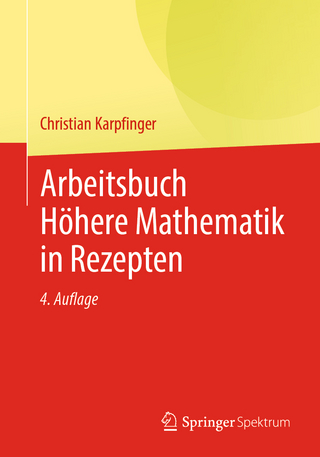
Elementary Algebra
Pearson (Verlag)
978-0-201-72961-0 (ISBN)
- Titel erscheint in neuer Auflage
- Artikel merken
Elementary Algebra is a book for the student. The authors' goal is to help build students' confidence, their understanding and appreciation of math, and their basic skills by presenting an extremely user-friendly text that models a framework in which students can succeed. Unfortunately, students who place into developmental math courses often struggle with math anxiety due to bad experiences in past math courses. Developmental students often have never developed nor applied a study system in mathematics. To address these needs, the authors have framed three goals for Elementary Algebra: 1) reduce math anxiety, 2) teach for understanding, and 3) foster critical thinking and enthusiasm.
The authors' writing style is extremely student-friendly. They talk to students in their own language and walk them through the concepts, explaining not only how to do the math, but also why it works and where it comes from, rather than using the “monkey-see, monkey-do” approach that some books take.
Tom Carson- Tom Carson¿s first teaching experience was teaching guitar while an undergraduate student studying electrical engineering. That experience helped him to realize that his true gift and passion was, and is, in teaching. He went on to earn his M.A.T. in mathematics at the University of South Carolina. For the last ten years, he has been teaching at Midlands Technical College in the Developmental Mathematics Program, where he has been honored with a NISOD Excellence in Teaching award and a Who¿s Who among American Teachers award. Tom has served on the faculty council and has been a board member of the South Carolina Association of Developmental Educators (SCADE). Ever the teacher, Tom teaches outside the classroom by presenting at conferences such as NADE, AMATYC, and ICTCM on topics such as Combating Innumeracy, Writing in Mathematics, and Implementing a Study System. Ellyn GillespieAfter several career changes, Ellyn Gillespie found her calling. While working in a campus bookstore, she was hired to teach a developmental math class and immediately knew that teaching was what she had been looking for. After completing her M. A. T. in mathematics at The Citadel, she went on to teach at several colleges throughout SC. For the past 6 years, she has been at Midlands Technical College, teaching in both the Developmental Studies and Mathematics departments. Honored three times as a Who¿s Who Among America¿s Teachers, Ellyn continues to show her enthusiasm in and out of the classroom. She serves on the college¿s Internet and Technology Committee and works to introduce technology in the classroom. Also a member of the state¿s Developmental Studies Mathematics Peer Group, she works to improve mathematics instruction throughout the state. Ellyn continues to share her knowledge with others and has presented at NADE and NCTM conferences.
1. Foundations of Algebra.
Number Sets and the Structure of Algebra.
Fractions.
Adding and Subtracting Real Numbers; Properties of Real Numbers.
Multiplying and Dividing Real Numbers; Properties of Real Numbers.
Exponents, Roots, and Order of Operations.
Translating Word Phrases to Expressions.
Evaluating and Rewriting Expressions.
2. Solving Linear Equations and Inequalities.
Equations, Formulas, and the Problem Solving Process.
The Addition Principle.
The Multiplication Principle.
Applying the Principles to Formulas.
Translating Word Sentences to Equations.
Solving Linear Inequalities.
3. Problem Solving.
Ratios and Proportions.
Percents.
Problems with Two or More Unknowns.
Rates.
Investment and Mixture.
4. Graphing Linear Equations and Inequalities.
The Rectangular Coordinate System.
Graphing Linear Equations.
Graphing Using Intercepts.
Slope-Intercept Form.
Point-Slope Form.
Graphing Linear Inequalities.
Introduction to Functions and Function Notation.
5. Polynomials.
Exponents and Scientific Notation.
Introduction to Polynomials.
Adding and Subtracting Polynomials.
Exponent Rules and Multiplying Monomials.
Multiplying Polynomials; Special Products.
Exponent Rules and Dividing Polynomials.
6. Factoring Polynomials.
Greatest Common Factor and Factoring by Grouping.
Factoring Trinomials of the Form ax² + bx + c when a = 1.
Factoring Trinomials of the Form ax² + bx + c when a 1.
Factoring Special Products.
Strategies for Factoring.
Solving Quadratic Equations by Factoring.
Graphing of Quadratic Equations and Functions.
7. Rational Expressions and Equations.
Simplifying Rational Expressions.
Multiplying and Dividing Rational Expressions.
Adding and Subtracting Rational Expressions with the Same Denominator.
Adding and Subtracting Rational Expressions with Different Denominators.
Complex Rational Expressions.
Solving Equations Containing Rational Expressions.
Further Applications with Rational Expressions (Variation).
8. Systems of Equations.
Solving Systems of Linear Equations Graphically.
Solving Systems of Linear Equations by Substitution.
Solving Systems of Linear Equations by Elimination.
More Applications with Systems of Equations.
Solving Systems of Linear Inequalities.
9. Roots and Radicals.
Square Roots and Radical Expressions.
Multiplying and Simplifying Square Roots.
Dividing and Simplifying Square Roots.
Adding and Subtracting Square Roots.
Solving Radical Equations.
Higher Roots and Rational Exponents.
10. Quadratic Equations.
The Principle of Square Roots.
Solving Quadratic Equations by Completing the Square.
Solving Quadratic Equations using the Quadratic Formula.
Complex Numbers.
Graphing Quadratic Equations.
| Erscheint lt. Verlag | 21.8.2003 |
|---|---|
| Zusatzinfo | illustrations |
| Sprache | englisch |
| Maße | 221 x 262 mm |
| Gewicht | 2003 g |
| Themenwelt | Mathematik / Informatik ► Mathematik ► Algebra |
| ISBN-10 | 0-201-72961-X / 020172961X |
| ISBN-13 | 978-0-201-72961-0 / 9780201729610 |
| Zustand | Neuware |
| Haben Sie eine Frage zum Produkt? |
aus dem Bereich



